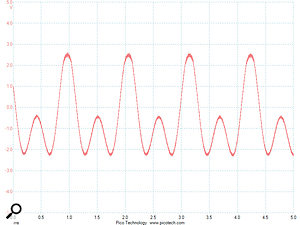 This image show the 'rounding' effect of the X-DREI processing on a 1kHz square-wave input signal. The input and output signals are overlaid. The apparent polarity inversion is an artefact of the oscilloscope's triggering and is not present in reality.
This image show the 'rounding' effect of the X-DREI processing on a 1kHz square-wave input signal. The input and output signals are overlaid. The apparent polarity inversion is an artefact of the oscilloscope's triggering and is not present in reality. The same rounding effect, this time on a triangle wave.
The same rounding effect, this time on a triangle wave. An asymmetrical waveform created in Adobe Audition...
An asymmetrical waveform created in Adobe Audition... ...and the symmetrical output from the X-DREI Pro.
...and the symmetrical output from the X-DREI Pro. The phase response of the X-DREI Pro, showing several complete 360-degree rotations across the full bandwidth.
The phase response of the X-DREI Pro, showing several complete 360-degree rotations across the full bandwidth. The X-DREI's frequency response, in three mode settings. The response is not flat, and there is an overall gain boost of about 3dB! In mastering mode the response is broadly flat between about 10Hz and 30kHz, but with a modest two-octave dip centred at 5kHz. Switching to the mid and end settings of the sound-stage control produces increasing levels of boost above 300Hz, with a corresponding cut below 300Hz. The 5kHz dip remains in all cases.
The X-DREI's frequency response, in three mode settings. The response is not flat, and there is an overall gain boost of about 3dB! In mastering mode the response is broadly flat between about 10Hz and 30kHz, but with a modest two-octave dip centred at 5kHz. Switching to the mid and end settings of the sound-stage control produces increasing levels of boost above 300Hz, with a corresponding cut below 300Hz. The 5kHz dip remains in all cases. The green trace in this plot shows a group-delay of almost 2.5ms below 300Hz introduced by the X-Drei processing. The purple trace is the inherent group delay of the AP analyser.
The green trace in this plot shows a group-delay of almost 2.5ms below 300Hz introduced by the X-Drei processing. The purple trace is the inherent group delay of the AP analyser. This total harmonic distortion (THD) and noise chart reveals varying levels of distortion with frequency (green trace), peaking at a surprisingly high 0.1 percent below 300Hz. The purple trace is the residual distortion of the Audio Precision analyser.
This total harmonic distortion (THD) and noise chart reveals varying levels of distortion with frequency (green trace), peaking at a surprisingly high 0.1 percent below 300Hz. The purple trace is the residual distortion of the Audio Precision analyser.
These graphs accompany the review of Neutral Audio's X-DREI Pro (/sos/aug13/articles/neutral-xdrei.htm).
I measured the noise, distortion, group-delay, frequency and phase responses of the X-DREI Pro under various operating conditions, using an Audio Precision analyser. Scroll through the photos below to see the results!
